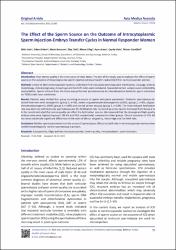The effect of the sperm source on the outcome of intracytoplasmic Sserm injection-embryo transfer cycles in normal responder women

Göster/
Erişim
info:eu-repo/semantics/openAccessTarih
2016Yazar
Usta, AkınErdem, Erkan
Karacan, Meriç
Cebi, Ziya
Uluğ, Murat
Arvas, Ayşe
Usta, Ceyda
Çamlibel, Teksen
Üst veri
Tüm öğe kaydını gösterÖzet
Introduction: Poor semen quality is the main cause of male factor. The aim of this study was to evaluate the effect of sperm source on the outcome of intracytoplasmic sperm injection-embryo transfer cycles (ICSI-ET) in normoresponder women.Methods: A total of 884 normoresponder women, underwent first ICSI cycles were evaluated. Fertilization, cleavage, embryo morphology, clinical pregnancy, miscarriage and live birth rates were compared. Ejaculated semen samples were collected by masturbation. Sperm retrieval from the testis was performed percutaneously by microdissection testicular sperm extraction (m-TESE) under local anesthesia.Results: Patients were divided four group according to source of sperm and sperm parameters. Testicular spermatozoa obtained from men with azoospermia (group 1, n=43), severe oligoasthenoteratozoospermia (sOAT), (group 2, n=93), oligoasthenoteratozoospermia (OAT) (group 3, n=209) and normal semen analysis (group 4, n=539). The most reduced fertilization rate was observed with testicular spermatozoa and the fertilization rate increased as semen quality increased from Group 2 to 4. Our results indicated that semen quality can affect the fertilization process. We observed that the cleavage and high-quality embryo rates were highest in group I (88.4% and 93%, respectively) compared to other groups. Clinical outcomes of ICSI did not show statistically significant differences in the rates of clinical pregnancy, miscarriage and live birth rate.Conclusion: Neither sperm parameters nor the source of spermatozoa affects live birth rate in normoresponder women when motile/morphologically normal spermatozoa is present. Introduction: Poor semen quality is the main cause of male factor. The aim of this study was to evaluate the effect of sperm source on the outcome of intracytoplasmic sperm injection-embryo transfer cycles (ICSI-ET) in normoresponder women.Methods: A total of 884 normoresponder women, underwent first ICSI cycles were evaluated. Fertilization, cleavage, embryo morphology, clinical pregnancy, miscarriage and live birth rates were compared. Ejaculated semen samples were collected by masturbation. Sperm retrieval from the testis was performed percutaneously by microdissection testicular sperm extraction (m-TESE) under local anesthesia.Results: Patients were divided four group according to source of sperm and sperm parameters. Testicular spermatozoa obtained from men with azoospermia (group 1, n=43), severe oligoasthenoteratozoospermia (sOAT), (group 2, n=93), oligoasthenoteratozoospermia (OAT) (group 3, n=209) and normal semen analysis (group 4, n=539). The most reduced fertilization rate was observed with testicular spermatozoa and the fertilization rate increased as semen quality increased from Group 2 to 4. Our results indicated that semen quality can affect the fertilization process. We observed that the cleavage and high-quality embryo rates were highest in group I (88.4% and 93%, respectively) compared to other groups. Clinical outcomes of ICSI did not show statistically significant differences in the rates of clinical pregnancy, miscarriage and live birth rate.Conclusion: Neither sperm parameters nor the source of spermatozoa affects live birth rate in normoresponder women when motile/morphologically normal spermatozoa is present.

















